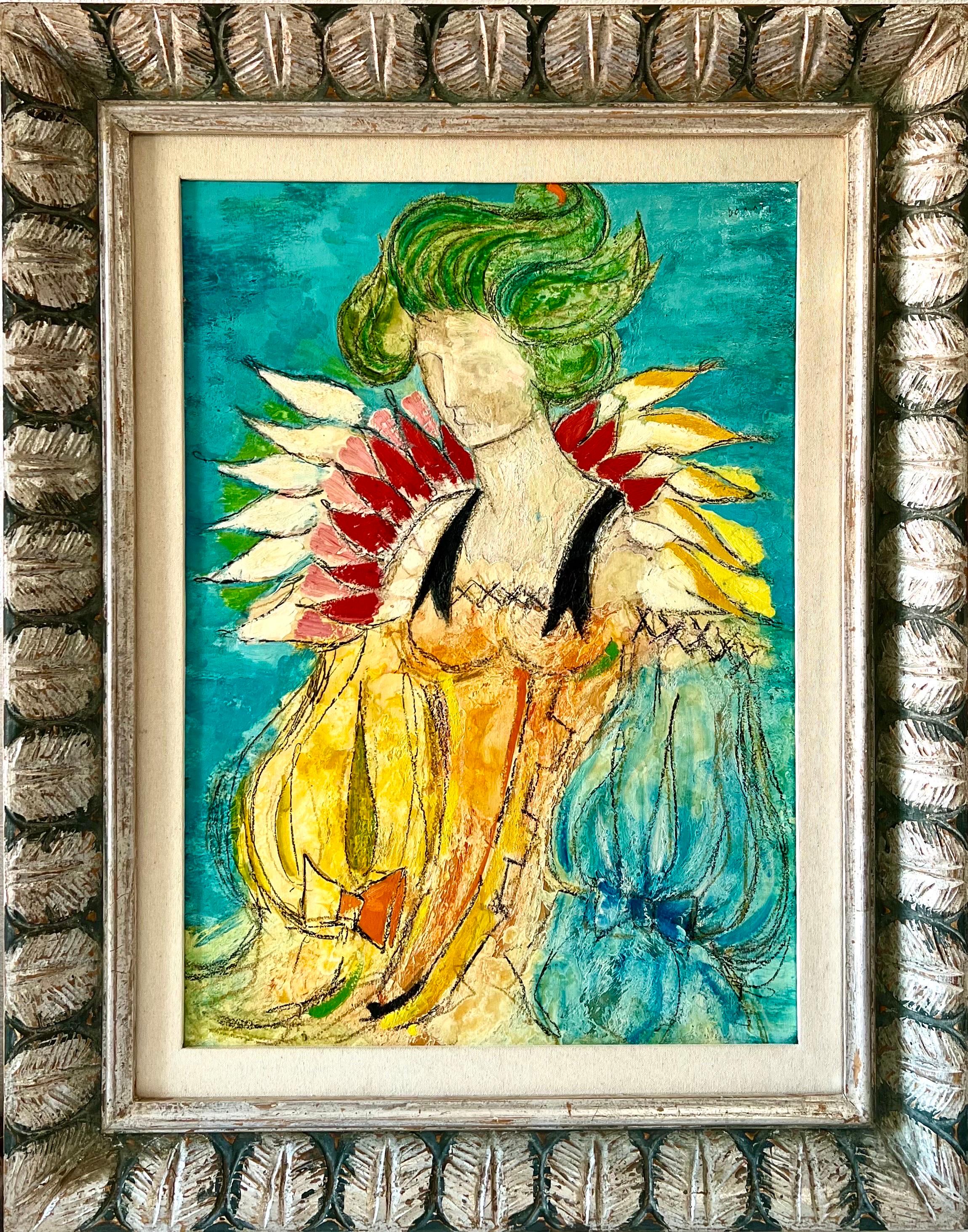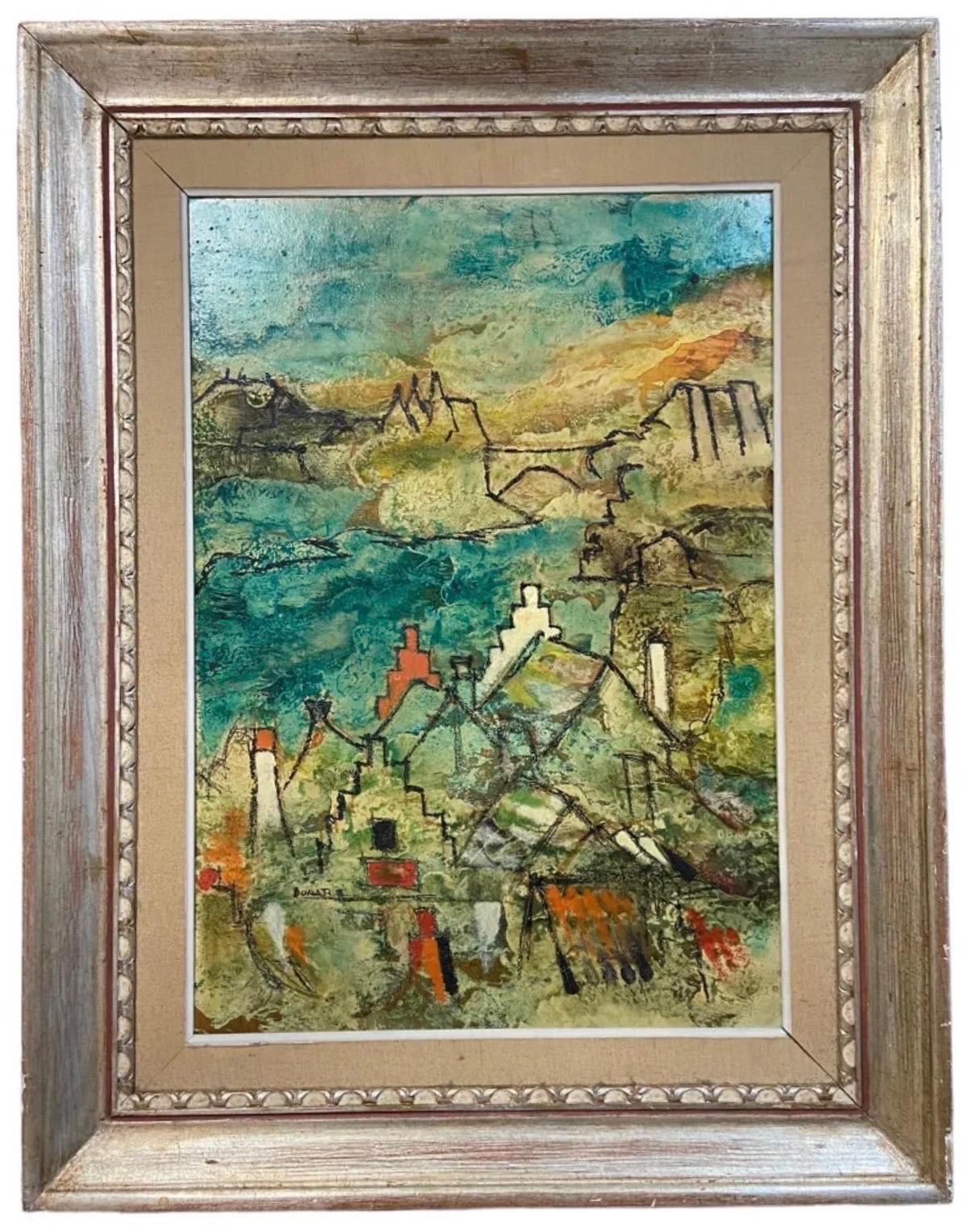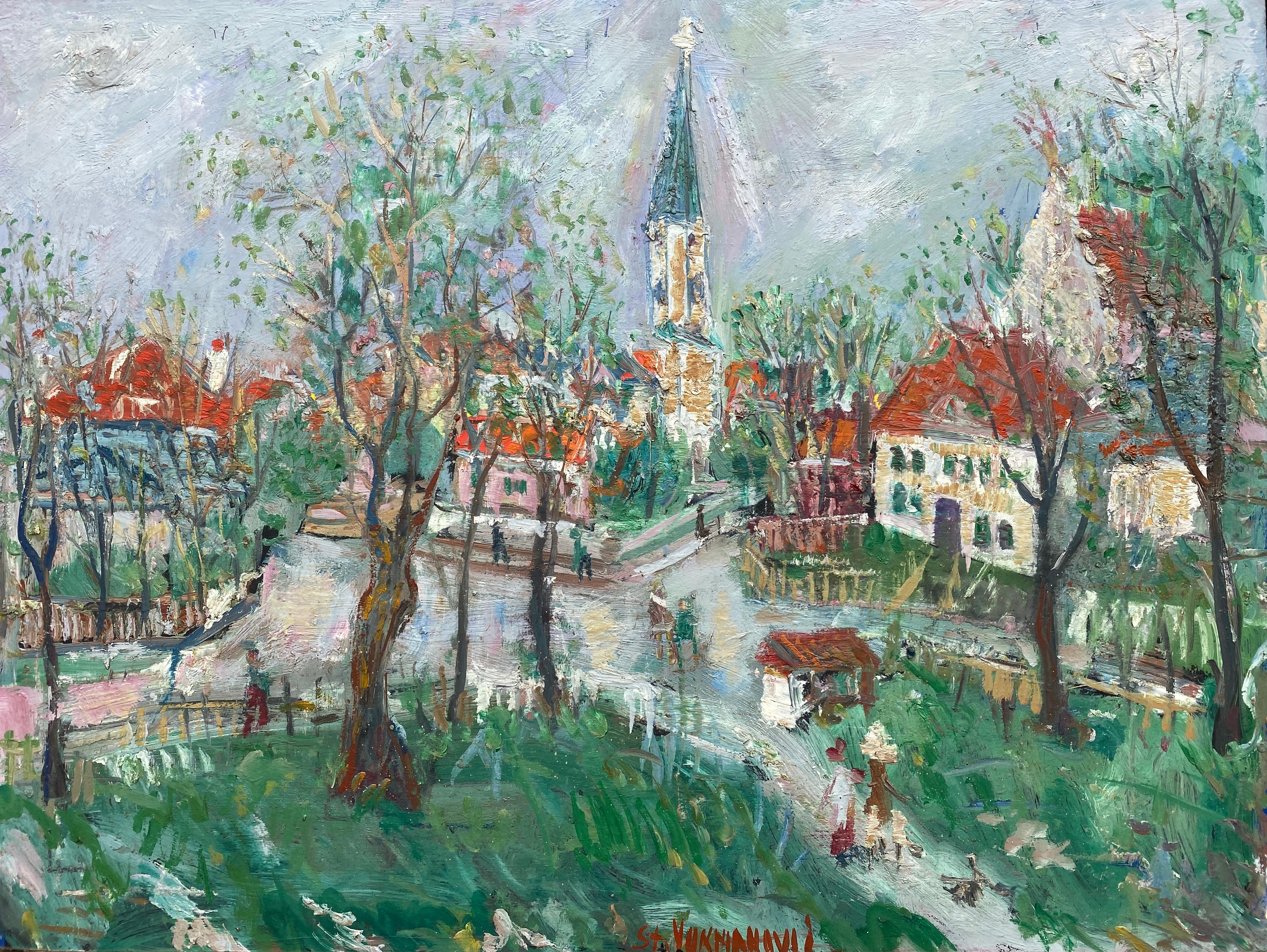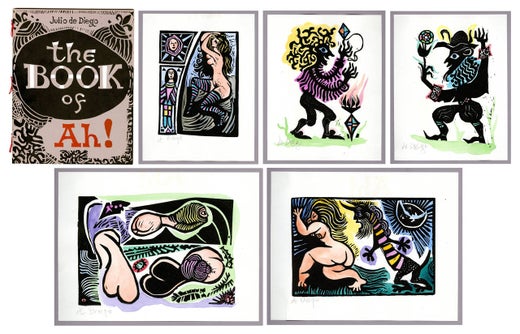Julio de DiegoTlaloc and the Tiger oil painting by Julio de Diego1939
1939
About the Item
- Creator:Julio de Diego (1900-1979, American)
- Creation Year:1939
- Dimensions:Height: 16 in (40.64 cm)Width: 12 in (30.48 cm)
- Medium:
- Movement & Style:
- Period:
- Condition:
- Gallery Location:Hudson, NY
- Reference Number:
Julio de Diego
Julio De Diego was one of the most colorful artists to work in Chicago. Born in Madrid in 1900, he left home at the age of 15 to apprentice as a scene painter for theatres. After service in the Spanish army, including six months fighting in North Africa, Diego traveled to Paris and Rome to study art. He also appeared as an extra in Diaghilev’s Ballet Russes. He emigrated to the United States in 1924. He lived in New York for two years, then went to Chicago, where he remained until 1942. At first, he earned a living as a magazine illustrator, decorative painter and graphic designer. By the early 1930s, Diego began to show regularly at the Art Institute of Chicago, appearing at thirty-two annual exhibitions of Chicago Artists, American artists and watercolorists, between 1931–47. He was employed by the easel division of the Illinois Art Project during the mid-1930s. He traveled to Mexico for the first time in 1939, becoming close friends with Carlos Mérida. Diego was deeply affected by the Spanish Civil War, and many of his works reflect the conflict that presaged the Second World War. Meditation over Inexplicable Logic seems to be a kind of preparation for his self-portrait in the Art Institute’s collection, titled The Perplexity of What To Do (1940). Both feature isolated, brooding figures lost in their inability to respond to events. He left Chicago in 1942 but continued to exhibit his work at major institutions. In 1946, Life magazine’s article described him spending time “cooking aromatic Spanish dishes and reading works of Spanish mystical philosophers and poets. He smokes cigarettes incessantly and dresses flamboyantly, affecting cerise mufflers and jangling bracelets.” Diego gained more notoriety in 1948 when he married the great burlesque artist, Gypsy Rose Lee. After their separation and divorce in the mid-1950s, he lived for a time in New York at the Chelsea Hotel, a haunt of artists, musicians and poets. Diego settled in Sarasota, Florida in 1967, near former friends from Chicago, where he died in 1979. Daniel Schulman References “Julio De Diego: He Paints Weird War and Peace.” Life Magazine, March 11, 1946. De Diego, Julio. Pamphlet File P-07866. Ryerson Library, Art Institute of Chicago.
- ShippingRetrieving quote...Ships From: Hudson, NY
- Return PolicyThis item cannot be returned.
- Christmas Turkey & the General's Daughter painting by Julio De DiegoBy Julio de DiegoLocated in Hudson, NYThe artwork measures 18" x 24", and the frame 25" x 29.5" x 1.75". Upon request a video clip of this work may be provided. About this artist: Julio De Diego crafted a formidable per...Category
1960s Surrealist Interior Paintings
MaterialsWatercolor, Tempera, Paper
- Rescue abstract figurative oil painting by Maurice GolubovBy Maurice GolubovLocated in Hudson, NYRescue (c.1945) Oil on panel 14" x 17" 19 ½" x 22 ¼" x 1 ½" framed Signed "M. Golubov" lower right, titled "Rescue" verso. About this artist: "If you can imagine a point moving, i...Category
1940s Abstract Abstract Paintings
MaterialsOil, Panel
- A Musician oil painting by Frederick E. WrightLocated in Hudson, NYThis work of a young musician by Frederick E. Wright is set in an exceptional original Doll & Richards, Boston, frame. The framed dimensions are 16' x 13 1/3" x 1". A hand-written la...Category
Late 19th Century Abstract Impressionist Figurative Paintings
MaterialsOil, Panel
- Vienna Flower Market oil painting by Emil BarbariniLocated in Hudson, NYPainting measures 10 ½" x 16" and framed 20 ½" x 26" x 4"Category
1920s Impressionist Landscape Paintings
MaterialsPanel, Oil
- The Lonely Road by William Charles PalmerLocated in Hudson, NYThe Lonely Road (1940) Tempera on panel 12" x 16" 19 1/2" x 23 1/2" x 1 1/2" framed Hand-signed "Palmer '40" lower center. Provenance: Midtown Galleries, New York, NY (labels verso...Category
Mid-20th Century American Modern Figurative Paintings
MaterialsPanel, Tempera
- St. Atomic oil and tempera painting by Julio de DiegoBy Julio de DiegoLocated in Hudson, NYJulio De Diego’s Atomic Series paintings made an extraordinary statement regarding the shock and fear that accompanied the dawn of the nuclear age. In the artist’s own words, “Scientists were working secretly to develop formidable powers taken from the mysterious depths of the earth - with the power to make the earth useless! Then, the EXPLOSION! . . . we entered the Atomic Age, and from there the neo-Atomic war begins. Explosions fell everywhere and man kept on fighting, discovering he could fight without flesh.” To execute these works, De Diego developed a technique of using tempera underpainting before applying layer upon layer of pigmented oil glazes. The result is paintings with surfaces which were described as “bonelike” in quality. The forms seem to float freely, creating a three-dimensional visual effect. In the 1954 book The Modern Renaissance in American Art, author Ralph Pearson summarizes the series as “a fantastic interpretation of a weighty theme. Perhaps it is well to let fantasy and irony appear to lighten the devastating impact. By inverse action, they may in fact increase its weight.” Exhibited 1950 University of Illinois at Urbana "Contemporary American Painting" 1964 Marion Koogler McNay Art Institute, San Antonio, Texas This work retains its original frame which measures 54" x 36" x 2". About this artist: Julio De Diego crafted a formidable persona within the artistic developments and political struggles of his time. The artist characterized his own work as “lyrical,” explaining, “through the years, the surrealists, the social-conscious painters and the others tried to adopt me, but I went my own way, good, bad or indifferent.” [1] His independence manifested early in life when de Diego left his parent’s home in Madrid, Spain, in adolescence following his father’s attempts to curtail his artistic aspirations. At the age of fifteen he held his first exhibition, set up within a gambling casino. He managed to acquire an apprenticeship in a studio producing scenery for Madrid’s operas, but moved from behind the curtains to the stage, trying his hand at acting and performing as an extra in the Ballet Russes’ Petrouchka with Nijinsky. He spent several years in the Spanish army, including a six-month stretch in the Rif War of 1920 in Northern Africa. His artistic career pushed ahead as he set off for Paris and became familiar with modernism’s forays into abstraction, surrealism, and cubism. The artist arrived in the U.S. in 1924 and settled in Chicago two years later. He established himself with a commission for the decoration of two chapels in St. Gregory’s Church. He also worked in fashion illustration, designed magazine covers and developed a popular laundry bag for the Hotel Sherman. De Diego began exhibiting through the Art Institute of Chicago in 1929, and participated in the annual Chicago Artists Exhibitions, Annual American Exhibitions, and International Water Color Exhibitions. He held a solo exhibition at the Art Institute of Chicago in the summer of 1935. Though the artist’s career was advancing, his family life had deteriorated. In 1932 his first marriage dissolved, and the couple’s young daughter Kiriki was sent to live with friend Paul Hoffman. De Diego continued to develop his artistic vocabulary with a growing interest in Mexican art. He traveled throughout the country acquainting himself with the works of muralists such as Carlos Merida, and also began a collection of small native artifacts...Category
1940s American Modern Abstract Paintings
MaterialsMasonite, Oil, Tempera
- Italian Modernist Surrealist Woman Color Oil Painting Lazzaro Donati La ReginaBy Lazzaro DonatiLocated in Surfside, FLLazzaro Donati (Italian, 1926-1977) Oil on board. Colorful woman. La Regina (the Queen) Hand signed upper right. signed, titled on back of panel. Dimensions: (Frame) H 37" x W 29", (Panel) H 27.5" x W 20" Lazzaro Donati was born in Florence and attended the Academy of Fine Arts. He began to paint in 1953, and in 1955 held his first exhibition at the Indiano Gallery in Florence. Within three years eleven exhibitions followed in Italy, and as his reputation grew he was invited to give major exhibitions in London, Paris, New York, Chicago, Rio de Janeiro and Montevideo. He is considered one of the foremost contemporary Italian painters and his paintings hang in museums and private collections throughout the Americas, Europe and Asia. His work is recalling the works of the french Raoul Dufy, Dunoyer de Segonzac, Francois Gall and Jean Jansem. This particular work is reminiscent of the work of Manolo Valdes. Donati lived and worked at 24 Piazza Donatello in Florence, the square where generations of artists have created works worthy of the great Florentine tradition. As you entered the narrow hallway to his studio, a gilded life-size Venetian angel beckoned you to his door. Once inside, the present faded away and you found yourself in an atelier where early masters might have worked during the Renaissance. Within, luxurious Persian rugs set off the innumerable objects d’art and antique furnishings. Light poured in through the sloping glass wall on the north side. A dramatic stairway led to an overhanging balcony which served as a private gallery where the artist hung some of his favorite early works. To the left of the entrance was a smaller studio where Donati sculpted, with a window overlooking the famous old English cemetery where tourists laid flowers on the grave of Elizabeth Barrett Browning. In the main studio itself, where Donati received his clients in an atmosphere as polished as an office of a top executive, one hardly realized that it was here that the artist actually painted. His easel was covered with Persian blue velvet, the painting on the easel was already framed, his chair was upholstered in red velvet and on his palette the colors were arranged with the precision of a Byzantine mosaic. In a corner stand were his latest works, framed and ready to be sent off to his next exhibition in Europe or America. He spoke fluent French and English as well as some Spanish and German. “After all”, he said, “you've got to know how to sell...Category
1960s Surrealist Figurative Paintings
MaterialsOil, Panel
- Italian Modernist Surrealist Architecture Landscape Oil Painting Lazzaro DonatiBy Lazzaro DonatiLocated in Surfside, FLLazzaro Donati (Italian, 1926-1977) Oil on board. Colorful Architectural Italian Landscape. Porto Azzurro, 1964 Hand signed upper right. signed, titled on back of panel. Dimensions: (Frame) H 37" x W 29", (Panel) H 27" x W 19" Lazzaro Donati was born in Florence and attended the Academy of Fine Arts. He began to paint in 1953, and in 1955 held his first exhibition at the Indiano Gallery in Florence. Within three years eleven exhibitions followed in Italy, and as his reputation grew he was invited to give major exhibitions in London, Paris, New York, Chicago, Rio de Janeiro and Montevideo. He is considered one of the foremost contemporary Italian painters and his paintings hang in museums and private collections throughout the Americas, Europe and Asia. His work is recalling the works of the french Raoul Dufy, Dunoyer de Segonzac, Francois Gall and Jean Jansem. This particular work is reminiscent of the work of Manolo Valdes. Donati lived and worked at 24 Piazza Donatello in Florence, the square where generations of artists have created works worthy of the great Florentine tradition. As you entered the narrow hallway to his studio, a gilded life-size Venetian angel beckoned you to his door. Once inside, the present faded away and you found yourself in an atelier where early masters might have worked during the Renaissance. Within, luxurious Persian rugs set off the innumerable objects d’art and antique furnishings...Category
1960s Surrealist Figurative Paintings
MaterialsOil, Panel
- Italian Modernist Surrealist Woman Color Oil Painting Lazzaro Donati La SignoraBy Lazzaro DonatiLocated in Surfside, FLLazzaro Donati (Italian, 1926-1977) Oil on board. Colorful woman. La Signora, Vestita Di Giallo, 1969 Hand signed upper right. signed, titled on back of panel. Dimensions: (Frame) H 38" x W 30", (Panel) H 28" x W 20" Lazzaro Donati was born in Florence and attended the Academy of Fine Arts. He began to paint in 1953, and in 1955 held his first exhibition at the Indiano Gallery in Florence. Within three years eleven exhibitions followed in Italy, and as his reputation grew he was invited to give major exhibitions in London, Paris, New York, Chicago, Rio de Janeiro and Montevideo. He is considered one of the foremost contemporary Italian painters and his paintings hang in museums and private collections throughout the Americas, Europe and Asia. His work is recalling the works of the french Raoul Dufy, Dunoyer de Segonzac, Francois Gall and Jean Jansem. This particular work is reminiscent of the work of Manolo Valdes. Donati lived and worked at 24 Piazza Donatello in Florence, the square where generations of artists have created works worthy of the great Florentine tradition. As you entered the narrow hallway to his studio, a gilded life-size Venetian angel beckoned you to his door. Once inside, the present faded away and you found yourself in an atelier where early masters might have worked during the Renaissance. Within, luxurious Persian rugs set off the innumerable objects d’art and antique furnishings...Category
1960s Surrealist Figurative Paintings
MaterialsOil, Panel
- View of a Village Square, Stefan Vukmanovic, Belgrade 1924 – 1995 DegernauLocated in Bruges, BEView of a Village Square Vukmanovic Stefan Belgrade 1924 – 1995 Degernau Serbian Painter Signature: Signed bottom middle Medium: Oil on panel Dimensions: Image size 45 x 60 cm Biography: Vukmanovic (Vucmanovic) Stefan was born in 1924, in Belgrade, former Yugoslavia. He was a Serbian painter of landscapes and town scenes. Vukmanovic studied at the Munich Academy of Fine Arts with the master teacher and artist Charles Crodel (1894 – 1973). He was a member of the Munich Secession. In this statement of principles, the artists declared their intentions to move away from outmoded principles and a conservative conception of what art was. Throughout the 1930s, many political ideologies (Marxism, Socialism, Capitalist Democracy, Communism and Fascism) were engaged in struggles for dominance, and epitomised the political atmosphere of the era. Surrealism art...Category
20th Century Surrealist Landscape Paintings
MaterialsOil, Panel
- "Sidekick" Grackle Bird with Red Handkerchief Oil Painting by Christy StallopLocated in Denver, COChristy Stallop's "Sidekick" (2022) is an original oil painting on linen, measuring 14 x 11 inches. This striking portrait features a grackle adorned with a vibrant red bandana, set ...Category
2010s Surrealist Animal Paintings
MaterialsOil, Wood Panel
- "Effulgent, " Oil PaintingBy Alexandra ManukyanLocated in Denver, COAlexandra Manukyan's "Effulgent" is an original, handmade oil painting that depicts a female model covered with glittering gold clothing, jewelry and hea...Category
2010s Surrealist Portrait Paintings
MaterialsLinen, Oil, Wood Panel






